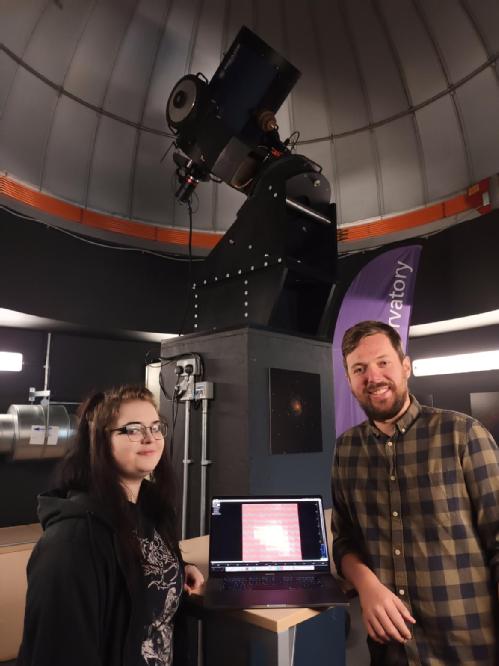Press Releases
New search finds 85 exoplanet candidates – as cool as planets in our own Solar System
Astronomers have discovered 85 possible planets outside of our solar system, with temperatures closer to those of our own Solar System planets, potentially cool enough to sustain life.
These exoplanet candidates, discovered using data from data from NASA's Transitioning Exoplanet Survey Satellite (TESS), are similar in size to Jupiter, Saturn and Neptune in our Solar System. They are much cooler than most of those found from the TESS mission.
TESS enables scientists to observe dips in the brightness of stars, known as ’transits’, caused by objects passing in front of them. It allows scientists to identify exoplanets and determine their size. Typically, at least three transits need to be seen to discover an exoplanet in this way, in order to determine how long they take to orbit their star.
However, in this new study, an international collaboration led by Faith Hawthorn at The University of Warwick, published in the Monthly Notices of the Royal Astronomical Society (MNRAS), systems that only transit twice were targeted. This results in exoplanet discoveries at longer orbital periods, which enables the discovery of exoplanets at cooler temperatures. The 85 candidate exoplanets take between 20 and 700 days to orbit their host stars, whereas most exoplanets observed by TESS have orbital periods of 3-10 days.
In some cases, the exoplanets are in regions far enough away from their host stars that they could be the right temperature to sustain life. This is known as the ‘habitable zone’. The researchers were keen to focus their observations on exoplanets in this region because it allows us to study exoplanets at temperatures closer to those seen on Solar System planets.
At this stage the bodies still need to be confirmed as exoplanets, but the researchers hope that this will be achieved with future observations. Of the 85 potential exoplanets detected in this study, 60 are brand new discoveries, while 25 have also been detected in the TESS data by independent research teams using different search techniques.
Faith Hawthorn, PhD researcher at the University of Warwick, said: “We ran an initial algorithm searching for transits on a sample of 1.4 million stars. After a painstaking vetting process, we whittled this down to just 85 systems that appear to host exoplanets that transit only twice in the dataset.”
Professor Daniel Bayliss, also involved in the research added: “It’s very exciting to find these planets, and to know that many of them may be in the right temperature zone to sustain life.
“The project was a real team effort and involved researchers at varying stages of their careers; it’s wonderful to see it come to light. Alongside the lead researcher, PhD student Faith Hawthorn, an undergraduate student Kaylen Smith Darnbrook helped us to analyse the data during a summer project. It is a major achievement for an undergraduate to have their research work published, so it was a proud moment for us all.
“Encompassing the collaborative spirit of the TESS mission, we have also made our discoveries public so that astronomers across the globe can study these unique exoplanets in more detail. We hope this will drive further research into these fascinating exoplanets.”
Faith added: “There is plenty of scope for continued research into these exoplanets - to learn more about their exact orbital periods, whether or not they have moons, and what exactly they are made of.”
Dr Sam Gill, second author of the study, noted: “Detecting exoplanets from just two transits is a clever way to find longer period exoplanets in transit surveys. It allows us to find planets that are much cooler than can be found with traditional transit searches.”
Read the paper here: https://warwick.ac.uk/fac/sci/physics/research/astro/people/faithhawthorne/duotransit_candidates.pdf
About Faith Hawthorn – please get in touch with the media team to set up interviews
Faith Hawthorn’s research is funded by UKRI (STFC).
Watch Faith talk about her research here https://www.youtube.com/watch?v=X9eR-0_gYO8&t=110s
Read more about Faith here https://warwick.ac.uk/fac/sci/physics/research/astro/people/faithhawthorn/

Faith Hawthorn and Dr Sam Gill at the Marsh Observatory on the University of Warwick campus.

The 85 new possible planets from the study, sized in relation to Jupiter and coloured by their approximate temperatures. The red planets are warmer, and the blue/purple planets are cooler.
Media contact
University of Warwick press office contact:
Annie Slinn 07876876934
Communications Officer | Press & Media Relations | University of Warwick Email: annie.slinn@warwick.ac.uk
Faith Hawthorn
PhD Researcher | Astronomy & Astrophysics Group | University of Warwick
Email: faith.hawthorn@warwick.ac.uk
24 January 2024
